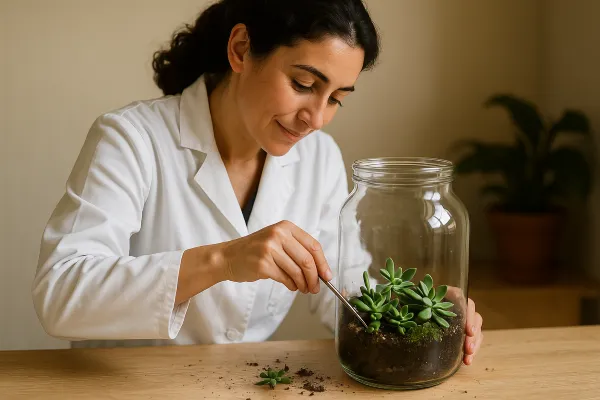Anyone wondering how to care for a terrarium usually discovers that these miniature ecosystems appear deceptively simple until condensation patterns become confusing or plants start showing stress. The beauty of glass-enclosed gardens lies in their self-sustaining nature, yet many terrarium enthusiasts find themselves second-guessing every droplet of moisture on the glass.
Behind every thriving terrarium lies understanding the delicate balance between light, moisture, and air circulation. These enclosed worlds mirror the complexity of nature itself, requiring observation rather than intervention, patience rather than frequent fussing.
Our question of June is: Is labradorite safe to use in damp terrariums?
How to care for a terrarium?
Proper terrarium care centers on monitoring condensation levels and providing bright, indirect light while avoiding overwatering—established terrariums typically need water only every 2-3 months. Success depends on understanding your terrarium as a complete ecosystem where every element works together to create stability.

Terrarium care differs fundamentally from traditional houseplant maintenance. Rather than following rigid watering schedules, you’ll learn to read the ecosystem’s signals through condensation patterns, plant behavior, and soil moisture levels. This approach transforms terrarium keeping from guesswork into informed observation.
Understanding light requirements
Terrariums thrive in bright natural light positions but must avoid direct sunlight, which can overheat the enclosed environment and cook the plants inside. North-facing windows provide ideal conditions in the northern hemisphere, offering consistent brightness without harsh afternoon sun.
The minimum light requirement for most terrarium plants is around 200 footcandles, though bright indirect light remains the gold standard for tropical species. Plants receiving insufficient light will show elongated growth, pale coloration, and reduced condensation activity within the terrarium.
Position your terrarium where you can read comfortably without feeling heat on your skin. Avoid moving terrariums frequently to chase or avoid light, as plants orient themselves to their light source and struggle when repeatedly repositioned. Instead, gradually turn the container over time if growth becomes lopsided.
Mastering the watering cycle
Experienced terrarium keepers often water their established systems only a couple times per year, as these closed environments create their own water cycle. Water only when condensation completely disappears from the glass throughout the day.
Use a spray bottle or mister to distribute water evenly, applying just a few sprays at a time to avoid oversaturation. Direct water at the base of plants rather than onto leaves, using a pipette or syringe for precision. Distilled or rainwater prevents mineral buildup that can cloud glass and harm plants.
Overwatering poses greater risks than underwatering in terrarium environments. Saturated substrate leads to root rot and fungal issues, while light moisture provides everything plants need. If overwatering occurs, absorb excess water with paper towels and leave the lid open until proper moisture levels return.
Reading condensation signals
Healthy terrariums show condensation up to one-third the height of the container, typically forming once daily. This natural cycle indicates active plant transpiration and proper moisture balance within the ecosystem.
Excessive condensation that obscures plants or creates water streaks signals too much moisture. Remove the lid for several hours daily until condensation covers only one-third of the glass, then reseal. Good air circulation prevents stagnant conditions that promote mold growth.
Complete absence of condensation indicates insufficient moisture. Add water gradually, a few tablespoons at a time, until daily condensation patterns resume. Trust the condensation indicator rather than arbitrary watering schedules—if condensation exists, additional water isn’t needed regardless of time elapsed.
Essential maintenance practices
Remove dead or dying plant material immediately to prevent rot and fungal spread. Use long scissors to trim overgrown foliage, maintaining desired shapes and preventing plants from outgrowing their container. Pruning growing tips encourages bushier, more attractive plant development.
Clean glass surfaces regularly with lint-free cloths and warm water to ensure adequate light penetration. Hard water deposits create white residue on glass, while cleaning products inside terrariums can harm plants. For new terrariums, provide a two-week “settling-in period” by opening the lid for several hours every few days.
Some mold presence indicates healthy decomposition, but excessive growth requires immediate attention. Remove moldy material and improve air circulation by temporarily opening the container. Monitor closely and adjust moisture levels to prevent recurrence.
Temperature and environmental control
Maintain consistent room temperatures around 19-21°C (66-70°F) for optimal terrarium performance. Avoid placing terrariums near heat sources or drafty areas that create temperature fluctuations disrupting humidity balance.
Tropical plants in closed terrariums adapt to the stable, humid conditions these systems provide. Open terrariums require different care approaches, with succulent varieties needing arid conditions and more frequent air circulation.
Season changes affect terrarium behavior. Summer heat may increase condensation activity, while winter heating systems can reduce humidity levels. Adjust your observation frequency and ventilation practices accordingly, always using condensation patterns as your primary guide.
Troubleshooting common issues
Plant stress signals include yellowing leaves, brown tips, or wilting despite adequate moisture. These symptoms often indicate lighting issues—too much direct sun causes scorching, while insufficient light prevents healthy growth. Evaluate light, water, temperature, and humidity needs before making adjustments.
Replace failing plants with species having similar size, moisture, and light requirements. Use tools like chopsticks or small spoons to minimize root disturbance during plant removal. Ensure new plantings have proper soil contact without air pockets around roots.
Persistent fogging beyond normal condensation patterns suggests ventilation problems. Covered terrariums benefit from weekly opening periods to promote fresh air exchange. Balance humidity retention with air circulation needs based on your specific plant selection and container design.
Conclusion
Last month, I carefully adjusted the moisture levels in my oldest terrarium—a five-year-old forest ecosystem that had developed its own perfect rhythm. Watching the condensation patterns shift and settle over the following days reminded me why terrarium care feels more like partnership than maintenance. Each successful terrarium represents countless small observations, patient adjustments, and trust in natural processes. Through understanding these principles, your miniature world will flourish with minimal intervention, creating the self-sustaining beauty that makes terrarium keeping so rewarding.
El Castor is your exclusive terrarium guide.
